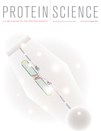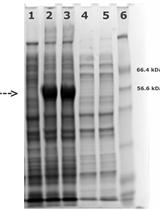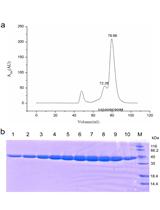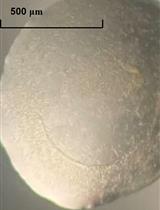- EN - English
- CN - 中文
Determination of Hydrodynamic Radius of Proteins by Size Exclusion Chromatography
分子排阻色谱法测定蛋白质的流体动力学半径
发布: 2017年04月20日第7卷第8期 DOI: 10.21769/BioProtoc.2230 浏览次数: 33599
评审: Yanjie LiWenrong HeMurugappan Sathappa
Abstract
Size exclusion chromatography (SEC) or gel filtration is a hydrodynamic technique that separates molecules in solution as a function of their size and shape. In the case of proteins, the hydrodynamic value that can be experimentally derived is the Stokes radius (Rs), which is the radius of a sphere with the same hydrodynamic properties (i.e., frictional coefficient) as the biomolecule. Determination of Rs by SEC has been widely used to monitor conformational changes induced by the binding of calcium (Ca2+) to many Ca2+-sensor proteins. For this class of proteins, SEC separation is based not just on the variation in protein size following Ca2+ binding, but likely arises from changes in the hydration shell structure.
This protocol aims to describe a gel filtration experiment on a prepacked column using a Fast Protein Liquid Chromatography (FPLC) system to determine the Rs of proteins with some indications that are specific for Ca2+ sensor proteins.
Background
Gel filtration separates molecules of different sizes and shapes based on their relative abilities to penetrate a bed of porous beads with well-defined pore sizes, which identifies the fractionation range. Molecules larger than the fractionation range, which are completely excluded from entering the pores, flow quickly through the column and elute first at the void volume (V0), which is the interstitial volume outside the support particles. Molecules smaller than the fractionation range, which are able to diffuse into the pores of the beads, have access to the total volume available to the mobile phase, therefore they move through the bed more slowly and elute last. Molecules with intermediate dimensions will be eluted with an elution volume (Ve) comprised between the void volume and the total volume available to the mobile phase (the smaller the molecule, the greater its access to the pores of the matrix, and thus the greater is its Ve).
The molecular weight of a protein can be determined by comparison of its elution volume parameter Kd, which represents the distribution of a given solute between the stationary and mobile phases (see Data analysis below), with those of different known calibration standards.
If the protein of interest has the same shape (generally globular) as the standard calibration proteins, the gel filtration experiment provides a good estimate of its molecular weight. However, because the shape of proteins can vary significantly and may be not known for an unknown protein, care must be taken in the determination of molecular size from elution volume. For example, a protein with an elongated shape could elute at a position that does not correspond to its dimension and which is significantly different from the position of a spherical protein having the same molecular weight. This is the case for some Ca2+ sensor proteins, e.g., calmodulins from different organisms (Sorensen and Shea, 1996; Sorensen et al., 2001; Astegno et al., 2014; Astegno et al., 2016; Vallone et al., 2016), which have anomalous migrations in gel filtration, resulting in a defined overestimation of the molecular weight due to their highly extended conformation. Thus, it is clear that in a gel filtration experiment the elution profile of proteins is closer to their Stokes radius (Rs) rather than to their molecular weight. Rs is a hydrodynamic value indicative of the apparent size of the dynamic solvated/hydrated protein.
For this reason, a SEC-based approach has been employed to resolve Ca2+-induced changes in the hydrated shape of Ca2+ sensor proteins by determination of their Rs in apo- and Ca2+-bound conditions. Ca2+ binding usually causes a decrease in the Rs (Sorensen and Shea, 1996; Sorensen et al., 2001; Astegno et al., 2016). The same SEC-based approach may be applicable to the detection of other protein-small molecule (e.g., other metals) interactions that cause changes in the structure of the protein to a less or more extended conformation (Asante-Appiah and Skalka, 1997; Bagai et al., 2007; De Angelis et al., 2010).
The values of Rs have been reported for a large number of proteins; in particular, some proteins are especially convenient for calibration of gel filtration columns (le Maire et al., 1986; Uversky, 1993) (Table 1). A gel filtration column can determine the hydrodynamic size, Rs, of a sample protein by comparison with the Rs of these water-soluble calibration proteins.
Table 1. Standards for calibrating analytical gel filtration
Materials and Reagents
- 0.22 µm syringe filters with low protein retention (Thermo Fischer Scientific, Thermo ScientificTM, catalog number: 42204-PV )
- 0.22 µm vacuum filtration unit (Sartorius, catalog number: 180C7-E )
- Superdex 200 10/300 GL prepacked column (GE Healthcare, catalog number: 17517501 )
- Superose 12 10/300 GL prepacked column (GE Healthcare, catalog number: 17-517-301 )
- 20% EtOH–minimum 1 L (Sigma-Aldrich, catalog number: 51976 )
- MilliQ water–minimum 1 L
- Protein markers:
Thyroglobulin (Sigma-Aldrich, catalog number: T9145 )
Apo-Ferritin (Sigma-Aldrich, catalog number: A3660 )
β-amylase (Sigma-Aldrich, catalog number: A8781 )
Catalase (Sigma-Aldrich, catalog number: C9322 )
Aldolase (Sigma-Aldrich, catalog number: A2714 )
Alcohol dehydrogenase (Sigma-Aldrich, catalog number: A8656 )
Albumin (Sigma-Aldrich, catalog number: A8531 )
Ovalbumin (Sigma-Aldrich, catalog number: A5503 )
Carbonic anhydrase (Sigma-Aldrich, catalog number: C7025 )
Myoglobin (Sigma-Aldrich, catalog number: M0630 )
Cytochrome c (Sigma-Aldrich, catalog number: C7150 ) - Gel filtration Calibration Kits with an optimized range of proteins are also commercially available:
- Gel Filtration Markers Kit for Protein Molecular Weights 29,000-700,000 Da (Sigma-Aldrich, catalog number: MWGF1000 )
- Gel Filtration Markers Kit for Protein Molecular Weights 12,000-200,000 Da (Sigma-Aldrich, catalog number: MWGF200 )
- Gel Filtration Markers Kit for Protein Molecular Weights 6,500-66,000 Da (Sigma-Aldrich, catalog number: MWGF70 )
- Gel Filtration Calibration Kits
High molecular weight (GE Healthcare, catalog number: 28-4038-42 )
Low molecular weight (GE Healthcare, catalog number: 28-4038-41 ) - Calcium chloride dihydrate (CaCl2·2H2O) (Sigma-Aldrich, catalog number: 21097 )
- Ethylene glycol-bis(2-aminoethylether)-N,N,N’,N’-tetraacetic acid (EGTA) (Sigma-Aldrich, catalog number: E4378 )
- Sodium hydroxide (NaOH) (Sigma-Aldrich, catalog number: 1.06462 )
- Hydrochloric acid (HCl) (Sigma-Aldrich, catalog number: H1758 )
- DL-dithiothreitol, anhydrous (DTT) (Sigma-Aldrich, catalog number: D9779 )
- Trizma® base (Sigma-Aldrich, catalog number: T1503 )
- Potassium chloride (KCl) (Sigma-Aldrich, catalog number: 31248 or P9333 )
Note: The product “ 31248 ” has been discontinued. - HEPES (Sigma-Aldrich, catalog number: H3375 )
- Sodium chloride (NaCl) (Sigma-Aldrich, catalog number: S7653 )
- Acetone (Sigma-Aldrich, catalog number: 439126 )
- Dextran blue (Sigma-Aldrich, catalog number: D4772 )
- 2 M CaCl2 (20 ml) (see Recipes)
- 0.1 M EGTA (100 ml, pH 8) (see Recipes)
- 0.1 M DTT (see Recipes)
- Mobile phase (see Recipes)
- 5 mM Tris, 150 mM KCl, pH 7.5 (for calibration of Superose 12 column 10/300GL)
- 5 mM Tris, 150 mM KCl, 5 mM EGTA, 1 mM DTT pH 7.5
- 5 mM Tris, 150 mM KCl, 5 mM CaCl2, 1 mM DTT pH 7.5
- 50 mM HEPES, 150 mM NaCl, 0.1 mM DTT pH 7.5 (for calibration of Superdex 200 10/300 GL)
- Total volume available to the mobile phase marker (see Recipes)
- Void volume marker (see Recipes)
- Protein calibration standards (see Recipes)
- Protein sample (see Recipes)
Equipment
- ÄKTA FPLC system (or similar liquid chromatography system, e.g., ÄKTA pure , ÄKTA prime plus , ÄKTA start ) including injector, one pump, UV-detector, Fraction collector (GE Healthcare, models: ÄKTA pure , ÄKTA prime plus , ÄKTA start )
Note: ÄKTA FPLC has been discontinued and replaced with ÄKTA pure . - Sample loop kit (GE Healthcare, catalog number: 18-0404-01 )
- Hamilton syringe (500 µl) (Hamilton, catalog number: 81217 or Sigma-Aldrich, catalog number: S9266 )
- Vacuum pump
- Tabletop centrifuge (Eppendorf, model: 5424 R )
Software
- UNICORNTM 4.0 control software for ÄKTA FPLC chromatography system (GE Healthcare)
- Origin 8.0 (OriginLab Corporation, Northampton, MA)
Procedure
文章信息
版权信息
© 2017 The Authors; exclusive licensee Bio-protocol LLC.
如何引用
La Verde, V., Dominici, P. and Astegno, A. (2017). Determination of Hydrodynamic Radius of Proteins by Size Exclusion Chromatography. Bio-protocol 7(8): e2230. DOI: 10.21769/BioProtoc.2230.
分类
生物化学 > 蛋白质 > 结构
您对这篇实验方法有问题吗?
在此处发布您的问题,我们将邀请本文作者来回答。同时,我们会将您的问题发布到Bio-protocol Exchange,以便寻求社区成员的帮助。
提问指南
+ 问题描述
写下详细的问题描述,包括所有有助于他人回答您问题的信息(例如实验过程、条件和相关图像等)。
Share
Bluesky
X
Copy link












